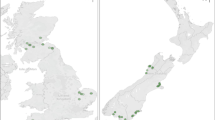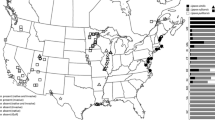Abstract
The enemy release hypothesis (ERH), which has been the theoretical basis for classic biological control, predicts that the success of invaders in the introduced range is due to their release from co-evolved natural enemies (i.e. herbivores, pathogens and predators) left behind in the native range. We tested this prediction by comparing herbivore pressure on native European and introduced North American populations of Hypericum perforatum (St John’s Wort). We found that introduced populations occur at larger densities, are less damaged by insect herbivory and suffer less mortality than populations in the native range. However, overall population size was not significantly different between ranges. Moreover, on average plants were significantly smaller in the introduced range than in the native range. Our survey supports the contention that plants from the introduced range experience less herbivore damage than plants from the native range. While this may lead to denser populations, it does not result in larger plant size in the introduced versus native range as postulated by the ERH.

Similar content being viewed by others
References
Blossey B, Nötzold R (1995) Evolution of increased competitive ability in invasive nonindigenous plants: a hypothesis. J Ecol 83:887–889
Buckley YM, Downey P, Fowler SV, Hill R, Memmot J, Norambuena H, Pitcairn M, Shaw R, Sheppard AW, Winks C, Wittenberg R, Rees M (2003) Are invasives bigger? A global study of seed size variation in two invasive shrubs. Ecology 84:1434–1440
Cox GW (1999) Alien species in North America and Hawaii: impacts on natural ecosystems. Island Press, Washington, D.C.
Crawley MJ (1987) What makes a community invisible? In: Gray AJ, Crawley MJ, Edwards PJ (eds) Colonization, succession and stability. Blackwell, Oxford, pp 429–453
Elton CS (1958) The ecology of invasions. Methuen, London
Grigulis K, Sheppard AW, Ash JE, Groves RH (2001) The comparative demography of the pasture weed Echium plantagineum between its native and invaded ranges. J Appl Ecol 38:281–290
Hoffmann JH, Moran VC (1998) The population dynamics of an introduced tree Sesbania punicea in South Africa in response to long-term damage caused by different combinations of three species of biological control agents. Oecologia 114:343–348
Hoffmann JH, Moran VC, Zedler DA (1998) Long-term population studies and the development of an integrated management programme for control of Opuntia stricta in Kruger National Park, South Africa. J Appl Ecol 35:156–160
Holloway JK, Huffaker CB (1951) The role of Chrysolina gemellata in the biological control of klamath weed. J Econ Entomol 44:244–247
Huffaker CB, Holloway JK (1949) Changes in range plant population structure associated with feeding of imported enemies of klamath weed (Hypericum perforatum L.). Ecology 30:167–175
Jakobs G, Weber E, Edwards PJ (2004) Introduced plants of the invasive Solidago gigantean (Asteraceae) are larger and grow denser than conspecifics in the native range. Divers Distrib 10:11–19
Julien MH, Griffiths MW (1998) Biological control of weeds: a world catalogue of agents and their target weeds. CABI, Wallingford
Knox JP, Dodge AD (1985) Isolation and activity of the photodynamic pigment hypericin. Plant Cell Environ 8:9–25
Leger EA, Rice KJ (2003) Invasive California poppies (Eschscholzia californica Cham.) grow larger than native individuals under reduced competition. Ecol Lett 6:257–264
Maron JL, Vilà M (2001) Do herbivores affect plant invasion? Evidence for the natural enemies and biotic resistance hypotheses. Oikos 95:363–373
Maron JL, Vilà M, Bommarco R, Elmendorf S, Beardsley P (2004) Rapid evolution of an invasive plant. Ecol Monogr 74:261–280
Maron J, Vilà M, Arnason J (in press) Loss of natural enemy resistance among introduced populations of St. John’s Wort (Hypericum perforatum). Ecology
Memmott J, Fowler SV, Paynter Q, Sheppard AW, Syrett P (2000) The invertebrate fauna on broom. Cytisus scoparius in two native and two exotic habitats. Acta Oecol 21:213–222
Mitchell CE, Power AG (2003) Release of invasive plants from fungal and viral pathogens. Nature 421:625–627
Parker IM, Simberloff D, Lonsdale WM, Goodell K, Wonham M, Kareiva PM, Williamson MH, Von Holle B, Moyle PB, Byers JE, Goldwasser L (1999) Impact: toward a framework for understanding the ecological effects of invaders. Biol Invasions 1:3–19
Paynter Q, Downey PO, Sheppard AW (2003) Age structure and growth of the woody legume weed Cytisus scoparius in native and exotic habitats: implications for control. J Appl Ecol 40:470–480
Sheppard AW, Hodge P, Paynter P, Rees M (2002) Factors affecting invasion and persistence of broom Cytisus scoparius in Australia. J Appl Ecol 39:721–734
Thébaud C, Simberloff D (2001) Are plants really larger in their introduced ranges? Am Nat 157:231–236
Vilà M, Gómez A, Maron JL (2003) Are alien plants more competitive than their native conspecifics? A test using Hypericum perforatum L. Oecologia 137:211–215
Wapshere AJ (1984) Recent work in Europe on biological control of Hypericum perforatum (Guttiferae) for Australia. Entomophaga 29:145–156
Weber E (2003) Invasive plant species of the world: a reference guide to environmental weeds. CABI, Wallingford
Willis AJ, Forrester RI (2000) Is there evidence for the post-invasion evolution of increased size among invasive plant species? Ecol Lett 3:275–283
Wolfe LM (2002) Why alien invaders succeed: support for the escape-from-enemy hypothesis. Am Nat 160:705–711
Acknowledgements
We are tremendously grateful to Libby Vanwyhe and Jennifer Williams for helping with the field survey, and Daniel Sol and four anonymous reviewers for comments on an earlier draft of the paper. This study was partially funded by NSF grant DB00-98377 to J. L. M. and by DGICYT (REN2000-0361/GLO) to M. V.
Author information
Authors and Affiliations
Corresponding author
Rights and permissions
About this article
Cite this article
Vilà, M., Maron, J.L. & Marco, L. Evidence for the enemy release hypothesis in Hypericum perforatum. Oecologia 142, 474–479 (2005). https://doi.org/10.1007/s00442-004-1731-z
Received:
Accepted:
Published:
Issue Date:
DOI: https://doi.org/10.1007/s00442-004-1731-z




